Minsu Cho
Part-Aware Bottom-Up Group Reasoning for Fine-Grained Social Interaction Detection
Nov 05, 2025Abstract:Social interactions often emerge from subtle, fine-grained cues such as facial expressions, gaze, and gestures. However, existing methods for social interaction detection overlook such nuanced cues and primarily rely on holistic representations of individuals. Moreover, they directly detect social groups without explicitly modeling the underlying interactions between individuals. These drawbacks limit their ability to capture localized social signals and introduce ambiguity when group configurations should be inferred from social interactions grounded in nuanced cues. In this work, we propose a part-aware bottom-up group reasoning framework for fine-grained social interaction detection. The proposed method infers social groups and their interactions using body part features and their interpersonal relations. Our model first detects individuals and enhances their features using part-aware cues, and then infers group configuration by associating individuals via similarity-based reasoning, which considers not only spatial relations but also subtle social cues that signal interactions, leading to more accurate group inference. Experiments on the NVI dataset demonstrate that our method outperforms prior methods, achieving the new state of the art.
Few-Shot Pattern Detection via Template Matching and Regression
Aug 25, 2025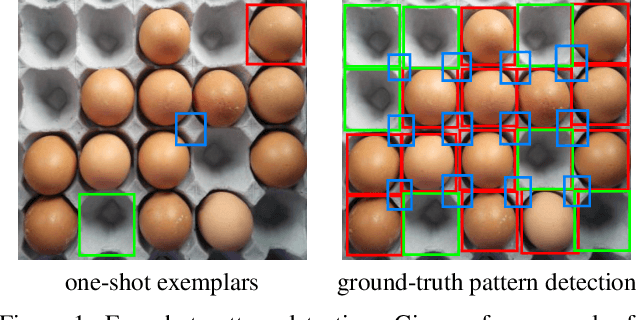

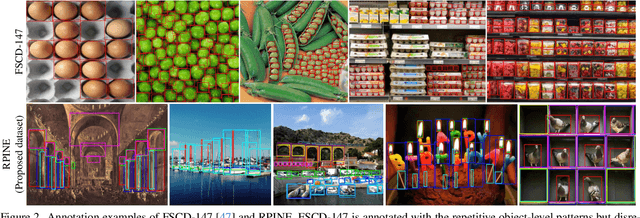
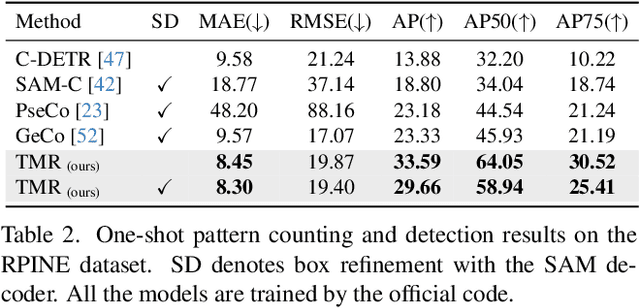
Abstract:We address the problem of few-shot pattern detection, which aims to detect all instances of a given pattern, typically represented by a few exemplars, from an input image. Although similar problems have been studied in few-shot object counting and detection (FSCD), previous methods and their benchmarks have narrowed patterns of interest to object categories and often fail to localize non-object patterns. In this work, we propose a simple yet effective detector based on template matching and regression, dubbed TMR. While previous FSCD methods typically represent target exemplars as spatially collapsed prototypes and lose structural information, we revisit classic template matching and regression. It effectively preserves and leverages the spatial layout of exemplars through a minimalistic structure with a small number of learnable convolutional or projection layers on top of a frozen backbone We also introduce a new dataset, dubbed RPINE, which covers a wider range of patterns than existing object-centric datasets. Our method outperforms the state-of-the-art methods on the three benchmarks, RPINE, FSCD-147, and FSCD-LVIS, and demonstrates strong generalization in cross-dataset evaluation.
Affogato: Learning Open-Vocabulary Affordance Grounding with Automated Data Generation at Scale
Jun 13, 2025Abstract:Affordance grounding-localizing object regions based on natural language descriptions of interactions-is a critical challenge for enabling intelligent agents to understand and interact with their environments. However, this task remains challenging due to the need for fine-grained part-level localization, the ambiguity arising from multiple valid interaction regions, and the scarcity of large-scale datasets. In this work, we introduce Affogato, a large-scale benchmark comprising 150K instances, annotated with open-vocabulary text descriptions and corresponding 3D affordance heatmaps across a diverse set of objects and interactions. Building on this benchmark, we develop simple yet effective vision-language models that leverage pretrained part-aware vision backbones and a text-conditional heatmap decoder. Our models trained with the Affogato dataset achieve promising performance on the existing 2D and 3D benchmarks, and notably, exhibit effectiveness in open-vocabulary cross-domain generalization. The Affogato dataset is shared in public: https://huggingface.co/datasets/project-affogato/affogato
Harnessing the Power of Training-Free Techniques in Text-to-2D Generation for Text-to-3D Generation via Score Distillation Sampling
May 26, 2025Abstract:Recent studies show that simple training-free techniques can dramatically improve the quality of text-to-2D generation outputs, e.g. Classifier-Free Guidance (CFG) or FreeU. However, these training-free techniques have been underexplored in the lens of Score Distillation Sampling (SDS), which is a popular and effective technique to leverage the power of pretrained text-to-2D diffusion models for various tasks. In this paper, we aim to shed light on the effect such training-free techniques have on SDS, via a particular application of text-to-3D generation via 2D lifting. We present our findings, which show that varying the scales of CFG presents a trade-off between object size and surface smoothness, while varying the scales of FreeU presents a trade-off between texture details and geometric errors. Based on these findings, we provide insights into how we can effectively harness training-free techniques for SDS, via a strategic scaling of such techniques in a dynamic manner with respect to the timestep or optimization iteration step. We show that using our proposed scheme strikes a favorable balance between texture details and surface smoothness in text-to-3D generations, while preserving the size of the output and mitigating the occurrence of geometric defects.
Locality-Aware Zero-Shot Human-Object Interaction Detection
May 26, 2025Abstract:Recent methods for zero-shot Human-Object Interaction (HOI) detection typically leverage the generalization ability of large Vision-Language Model (VLM), i.e., CLIP, on unseen categories, showing impressive results on various zero-shot settings. However, existing methods struggle to adapt CLIP representations for human-object pairs, as CLIP tends to overlook fine-grained information necessary for distinguishing interactions. To address this issue, we devise, LAIN, a novel zero-shot HOI detection framework enhancing the locality and interaction awareness of CLIP representations. The locality awareness, which involves capturing fine-grained details and the spatial structure of individual objects, is achieved by aggregating the information and spatial priors of adjacent neighborhood patches. The interaction awareness, which involves identifying whether and how a human is interacting with an object, is achieved by capturing the interaction pattern between the human and the object. By infusing locality and interaction awareness into CLIP representation, LAIN captures detailed information about the human-object pairs. Our extensive experiments on existing benchmarks show that LAIN outperforms previous methods on various zero-shot settings, demonstrating the importance of locality and interaction awareness for effective zero-shot HOI detection.
Video Summarization with Large Language Models
Apr 15, 2025Abstract:The exponential increase in video content poses significant challenges in terms of efficient navigation, search, and retrieval, thus requiring advanced video summarization techniques. Existing video summarization methods, which heavily rely on visual features and temporal dynamics, often fail to capture the semantics of video content, resulting in incomplete or incoherent summaries. To tackle the challenge, we propose a new video summarization framework that leverages the capabilities of recent Large Language Models (LLMs), expecting that the knowledge learned from massive data enables LLMs to evaluate video frames in a manner that better aligns with diverse semantics and human judgments, effectively addressing the inherent subjectivity in defining keyframes. Our method, dubbed LLM-based Video Summarization (LLMVS), translates video frames into a sequence of captions using a Muti-modal Large Language Model (M-LLM) and then assesses the importance of each frame using an LLM, based on the captions in its local context. These local importance scores are refined through a global attention mechanism in the entire context of video captions, ensuring that our summaries effectively reflect both the details and the overarching narrative. Our experimental results demonstrate the superiority of the proposed method over existing ones in standard benchmarks, highlighting the potential of LLMs in the processing of multimedia content.
Memory-Modular Classification: Learning to Generalize with Memory Replacement
Apr 08, 2025Abstract:We propose a novel memory-modular learner for image classification that separates knowledge memorization from reasoning. Our model enables effective generalization to new classes by simply replacing the memory contents, without the need for model retraining. Unlike traditional models that encode both world knowledge and task-specific skills into their weights during training, our model stores knowledge in the external memory of web-crawled image and text data. At inference time, the model dynamically selects relevant content from the memory based on the input image, allowing it to adapt to arbitrary classes by simply replacing the memory contents. The key differentiator that our learner meta-learns to perform classification tasks with noisy web data from unseen classes, resulting in robust performance across various classification scenarios. Experimental results demonstrate the promising performance and versatility of our approach in handling diverse classification tasks, including zero-shot/few-shot classification of unseen classes, fine-grained classification, and class-incremental classification.
Leveraging 3D Geometric Priors in 2D Rotation Symmetry Detection
Mar 27, 2025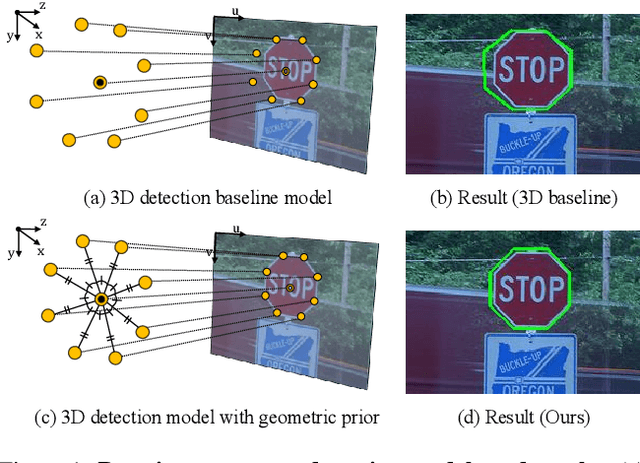
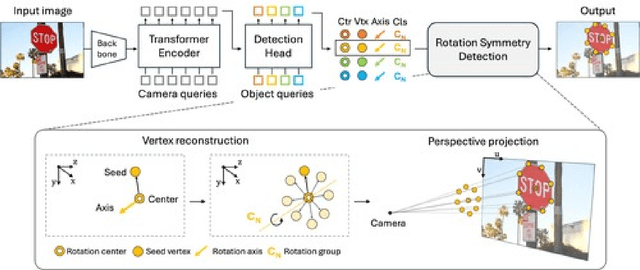
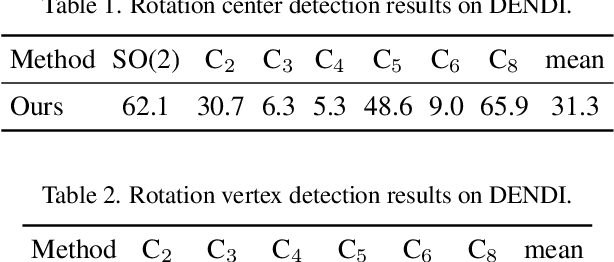
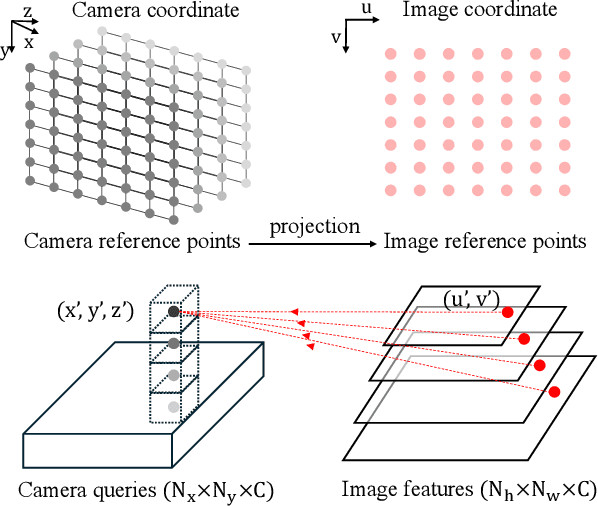
Abstract:Symmetry plays a vital role in understanding structural patterns, aiding object recognition and scene interpretation. This paper focuses on rotation symmetry, where objects remain unchanged when rotated around a central axis, requiring detection of rotation centers and supporting vertices. Traditional methods relied on hand-crafted feature matching, while recent segmentation models based on convolutional neural networks detect rotation centers but struggle with 3D geometric consistency due to viewpoint distortions. To overcome this, we propose a model that directly predicts rotation centers and vertices in 3D space and projects the results back to 2D while preserving structural integrity. By incorporating a vertex reconstruction stage enforcing 3D geometric priors -- such as equal side lengths and interior angles -- our model enhances robustness and accuracy. Experiments on the DENDI dataset show superior performance in rotation axis detection and validate the impact of 3D priors through ablation studies.
Mosaic3D: Foundation Dataset and Model for Open-Vocabulary 3D Segmentation
Feb 04, 2025

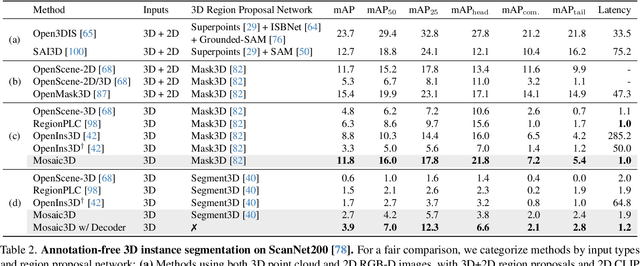

Abstract:We tackle open-vocabulary 3D scene understanding by introducing a novel data generation pipeline and training framework. Our method addresses three critical requirements for effective training: precise 3D region segmentation, comprehensive textual descriptions, and sufficient dataset scale. By leveraging state-of-the-art open-vocabulary image segmentation models and region-aware Vision-Language Models, we develop an automatic pipeline that generates high-quality 3D mask-text pairs. Applying this pipeline to multiple 3D scene datasets, we create Mosaic3D-5.6M, a dataset of over 30K annotated scenes with 5.6M mask-text pairs, significantly larger than existing datasets. Building upon this data, we propose Mosaic3D, a foundation model combining a 3D encoder trained with contrastive learning and a lightweight mask decoder for open-vocabulary 3D semantic and instance segmentation. Our approach achieves state-of-the-art results on open-vocabulary 3D semantic and instance segmentation tasks including ScanNet200, Matterport3D, and ScanNet++, with ablation studies validating the effectiveness of our large-scale training data.
ActFusion: a Unified Diffusion Model for Action Segmentation and Anticipation
Dec 05, 2024
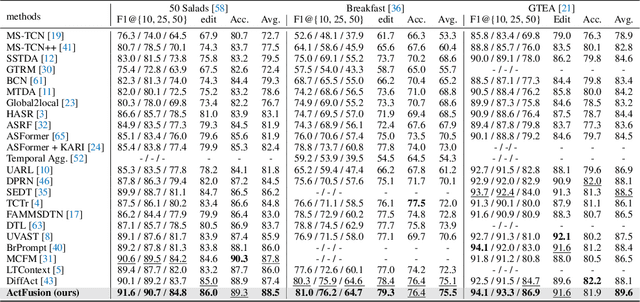
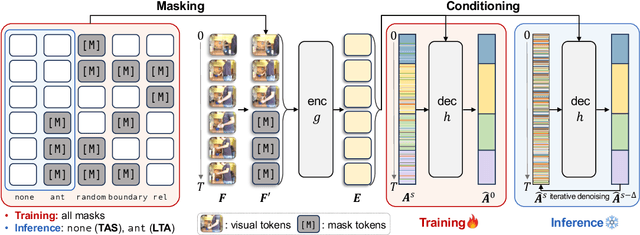
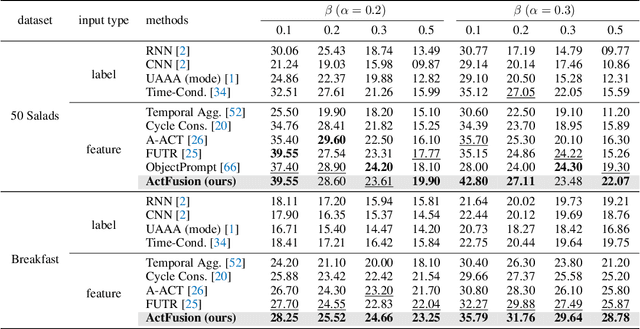
Abstract:Temporal action segmentation and long-term action anticipation are two popular vision tasks for the temporal analysis of actions in videos. Despite apparent relevance and potential complementarity, these two problems have been investigated as separate and distinct tasks. In this work, we tackle these two problems, action segmentation and action anticipation, jointly using a unified diffusion model dubbed ActFusion. The key idea to unification is to train the model to effectively handle both visible and invisible parts of the sequence in an integrated manner; the visible part is for temporal segmentation, and the invisible part is for future anticipation. To this end, we introduce a new anticipative masking strategy during training in which a late part of the video frames is masked as invisible, and learnable tokens replace these frames to learn to predict the invisible future. Experimental results demonstrate the bi-directional benefits between action segmentation and anticipation. ActFusion achieves the state-of-the-art performance across the standard benchmarks of 50 Salads, Breakfast, and GTEA, outperforming task-specific models in both of the two tasks with a single unified model through joint learning.
 Add to Chrome
Add to Chrome Add to Firefox
Add to Firefox Add to Edge
Add to Edge